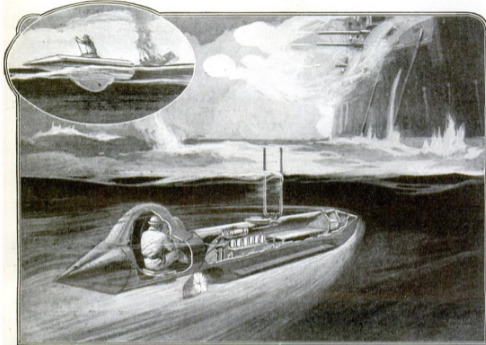Deadly man-steered torpedo
Contenuto
-
Titolo
-
Deadly man-steered torpedo
-
Article Title and/or Image Caption
-
A Deadly Man-Steered Torpedo. Would you pilot five hundred pounds of gun-cotton toward a hostile battleship and brave gun-fire?
-
extracted text
-
THE modern Whitehead automobile torpedo is by far the most feared weapon of modern naval warfare. It is, in effect, a little automatic submarine boat, with engines and rudders controlled by a mechanical brain. The soul of the torpedo is the gyroscope—a flywheel spinning at several thousand revolutions per minute. Unfortunately, this flywheel loses speed from the moment of launching. Modern naval battles are fought at ranges of five to ten miles. The Whitehead torpedo is inaccurate at such distances. Indeed, in the whole history of naval warfare the torpedo has reached its target only at short ranges.
Among the plans which have been suggested for increasing the effectiveness of the torpedo, perhaps the most daring is that of providing it with a real brain and a real controlling hand in the shape of a man. Commander Davis of the United States Navy designed a little vessel, some years ago, which was to contain a huge explosive charge and which was to be guided by a super-bold mariner against a battleship amid a storm of bullets. That men will volunteer for such hazardous work recent wars have abundantly demonstrated. We have only to remember how the Merrimac was sunk in the mouth of Santiago harbor, during the Spanish-American war, in the effort to imprison the Spanish ships believed to lie within. Dozens of men volunteered to block the channel under the fire of Spanish guns.
Hence, when Jacob S. Walch, of Walla Walla, Washington, suggests a torpedo controlled by a pilot carried along on its flight, we can well believe that he has not underestimated human courage.
He builds his torpedo so that the part in which the pilot sits may be detached after the explosive charge has been released to proceed under its own automatic control.
The detachable, pilot-carrying portion is attached to the main body of the torpedo and the various levers and controlling devices are all within the reach of the operator. When the torpedo is traveling on the surface of the water, partly submerged, the compressed air used by the engine may be taken from an air-chamber, which is in communication with the atmosphere, through vertical tubes resembling periscopes. When the forepart is to be submerged to a greater depth the tubes are lowered and the engine is then supplied with gas from a compressed-gas tank. The depth of submergence may be regulated by the inclination of planes at the side of the body.
When the torpedo has been brought to proper striking distance by the pilot, who has meanwhile fixed the control for the correct course and the proper submergence, a rod is operated which causes pressure from the compressed air tank to separate the torpedo body from the pilot section. As soon as the pilot section is free from the main body of the torpedo, the weight of the conning-tower portion causes the section to turn over, the top now acting as a keel. After opening the hatch-way, the pilot maneuvers his way back to his vessel.
-
Autore secondario
-
Jacob S. Walch (inventor)
-
Lingua
-
eng
-
Data di rilascio
-
1916-11
-
pagine
-
694-695
-
Diritti
-
Public Domain (Google digitized)
-
Archived by
-
Filippo Valle
-
Alberto Bordignon (Supervisor)

